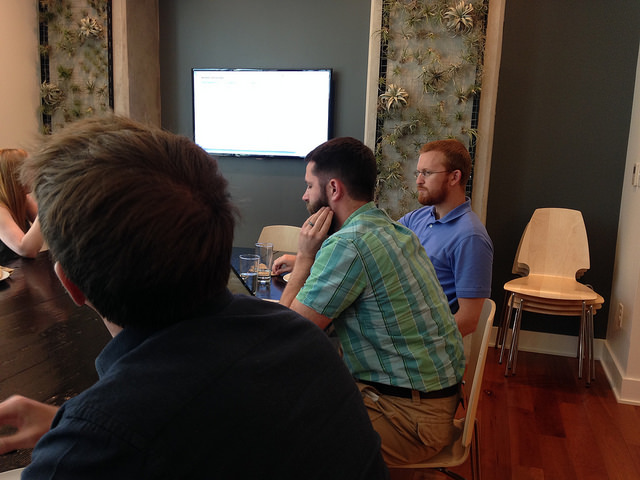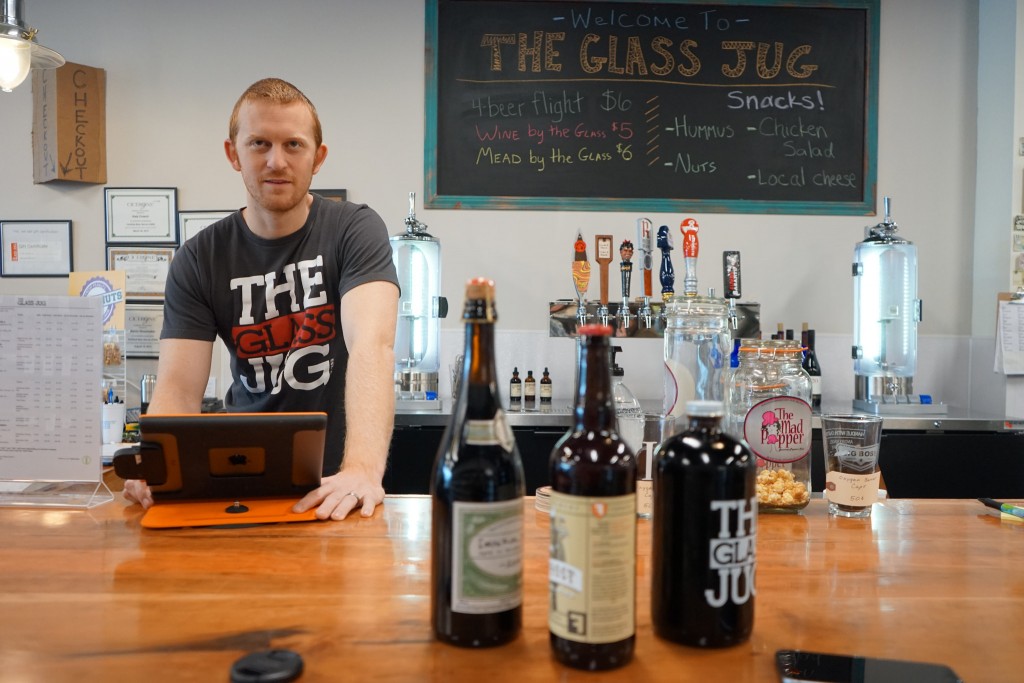
To give you an inside look at the people who make up Newfangled, we’re having our people interview each other. This month, designer Justin Kerr interviews senior strategist Chris Creech.
It’s been five years since Chris joined Newfangled right out of college. Now he heads up our rapidly expanding marketing automation department as a senior strategist. When he’s not at Newfangled, you can find Chris at his craft beer and bottle shop which he co-owns with his wife, Katy.
How did you come to work at Newfangled?
I started working at Newfangled right out of college. I was a senior at UNC Chapel Hill and frantically looking for any job that I could find. I was talking with a creative director from a local agency I had interned with a few years earlier, just trying to find connections. This was 2010, and no one was hiring, so we had a somewhat depressing meeting. On the way out, a girl that worked there said, “Hey, you know, you should talk to the guys over at Newfangled. I bet you’d really like those guys,” and I said, “OK, sounds great.”
I sent an email through the contact form on the Newfangled website and almost immediately got an email back from CEO Mark O’Brien, saying, “Thanks for applying for the job. We’d love to have you in for an interview.” I had no idea that Newfangled was hiring or what job I had just applied for.
Was your degree in marketing?
Technically, it was a degree in journalism with a focus in advertising. I assumed when Mark wrote me back that it must be some sort of project management job, but I couldn’t find it anywhere on the website. He had asked that I come in the next day for an interview, and I said, “Well, I’m on the crew team at Carolina, and we’re leaving tomorrow for a race out of town, so I can’t come tomorrow. Maybe sometime next week.” And he says, “Well, can you come in today?” Luckily, I’d had a presentation in one of my classes that day, so I was dressed somewhat nicely and said, “Sure, why not.”
After class I hopped on my bike, rode from Chapel Hill to Carrboro and interviewed for a job that I still didn’t know what it was. Mark will tell you to this day that he doesn’t recall interviewing me at all because this was just days before his daughter Iris was born, but apparently the interview was good enough to get me the job.
You were hired as a project manager. Did you feel confident?
Fair question. In college I had worked for three years at the Daily Tar Heel, the student-run newspaper, in the advertising department. In my senior year I was the manager of our advertising department and had a lot of client services experience. From that sense it was pretty seamless in terms of moving into another role working directly with clients. The difference between selling print ads versus project managing a website build was probably the bigger learning curve for me: the whole prototyping process and all of the thought that goes into the user experience and design of the website.
How long did you do project management before you transitioned into your current role as a strategist?
I was a project manager a little over two years when I began transitioning into the strategist position. It was a role that hadn’t existed previously, so I continued doing some project management work for the first three to six months. It was January 2014 when we took on our first clients for marketing automation. That came about because Mark had attended Dreamforce, the Salesforce conference in San Francisco, and had learned about this brand new thing called marketing automation and decided we needed to do this. We couldn’t miss it: It was something we had to do and we had to do it now.
Mark, COO Chris Butler and I went out to lunch, and they said, “Hey, we’ve got this idea, and we think that you might be the guy for the job. It’s called marketing automation.” I knew nothing about marketing automation other than having heard the term a time or two. Mark handed me a book that he picked up at Dreamforce and said, “Maybe you should start by reading this.”
While I was spending time learning marketing automation and implementing it for the Newfangled site, I started putting together a curriculum program for how we could apply it to client sites. About three months later we brought on our first round of clients for marketing automation, and almost all of them are still with us.
The strategy department has grown rather quickly.
Yeah — up until about a year ago we could we could wow people just by showing our Content Management System (CMS) and all of the things it could do, which included some of the building blocks of marketing automation. Now that we’ve adopted a separate, but integrated, marketing automation platform, in addition to our ever-evolving CMS, we’re able to really set ourselves apart. Well over half of our clients hire us not just for the website build but also for marketing automation training, consulting and setup.

Now that you’ve been a strategist for a while, what do you like best about the role?
We really get to know each client’s business model and get to know what they do, how they go about selling their product or service, and figure out the best way to implement our tools to help them achieve their goals in this system.
On the flipside of that, I love being able to see the results. We have direct revenue reporting to say, “Hey, the website generated X number of leads last month. Of those leads, 10 percent of them turned into good opportunities, and this month you closed three opportunities that came in through the website.” We can directly tie that revenue to the marketing efforts that they’re doing, and our clients are able to see the value of what we’re building both in the website and in the system surrounding it.
What’s the biggest challenge about being a strategist?
The biggest challenge for me is getting our clients to buy in and really use the system. Getting them to spend the time and/or to make the hires they need, dedicate resources to content creation, to email marketing, and to tracking their sales process inside of Salesforce or a CRM instead of just on their spreadsheets.
When you’re a small agency and you’ve got 20 people who are all dedicated to client work, it’s hard to dedicate a lot of resources to your own marketing efforts. I think they would all love to do it, but getting them to take that leap and dedicate the time and resources to it so that we can show them it’s working — that’s the tough part.
What’s your favorite thing about working at Newfangled?
Being able to work with all these different businesses and different clients and feel like we’re having a direct impact on what they’re doing, that’s a really rewarding experience. But also I just love coming in to the office every day and working with all the really smart, really motivated, really driven people that make up Newfangled. Finding a home at a company that is full of people like that is really encouraging, and I think it builds upon itself.
What do you do to recharge outside of work?
Well, trying to stay in shape and work out as best I can definitely helps. If I can get out, go for a run or a bike or a swim or something, that helps a lot and gets my mind off of everything else. I’ve competed in triathlons off and on over the past few years, shorter-distance to mid-distance ones. I roped Mark O’Brien into doing his first triathlon with me last fall, which was a lot of fun.
In addition to your duties at Newfangled, you’ve started a bottle shop called The Glass Jug. How did you get into beer brewing and starting up a business?
I started brewing with myself and four other folks when we were juniors in college. We were talking about what was on our bucket lists, and one of my roommates said, “One day I want to brew my own beer,” and I looked at him and said, “Well, we could do that.” And he said, “Yeah, I know it’s not something hard to do. It’s just I want to do it at some point.” So I said, “Well, no. I mean, we could do that now,” and so Katy, my girlfriend at the time, now wife, myself and a few other guys all chipped in 20 bucks so we could buy a starter home brew kit.
After college, Katy and I inherited the brewing equipment and expanded upon it, and got pretty involved in the homebrew scene, really learned a lot about the beer making process. It’s the most science I’ve ever done in my life. We met a lot of great people in the area, got involved in some of the homebrewing clubs, entered some competitions and had some success there. There was a short period of time when a lot of breweries were opening up in North Carolina and we thought we wanted to open a brewery, also, so we looked pretty seriously at that.
We decided instead to spend the money on a house, which I think was probably a better investment. About a year after that, a lot of the guys I had been homebrewing with were now head brewers at local breweries or running their own breweries and brewpubs. I saw there were all these breweries popping up but not a lot of places specializing in selling the beer that’s being made right in our backyard.

Katy and I decided that running a little retail shop and craft beer bar that focuses on local and craft beer was something we could do without the million-dollar investment of starting a brewery. Katy’s now doing that full time: She left her job and is the general manager at the store. I’m often referred to as our night and weekend volunteer over there because there hasn’t been a paycheck yet, but it’s been great.
The Glass Jug has really helped us to get to know a lot of people in this area and build a little community around the store. We’ve become a common meeting place for lots of folks and different clubs and groups. It’s become more than just a specialty retail store; it’s a place to hang out and build community which has been really fun to watch. The farmers market is in our parking lot every Saturday, so it’s the same people that are into the local food movement that are coming in for local beer each week, also.
I haven’t had the time recently to actually do much brewing for myself, but that’s the thing I love about Newfangled’s half-day Fridays in the summer: Those are my brew days. I can take off a little after noon, go home, and get started. That allows me to be done brewing by 5 or 6 o’clock, so I’m hoping to find a few Fridays this summer to knock out a few batches to share with the office.
If you’ve enjoyed this post (and would like to read more interviews with Newfanglers) let us know by submitting your comments below!
